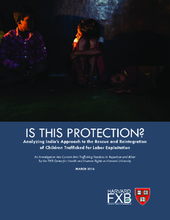Executive Summary
This report provides a comprehensive and critical analysis of the Indian government’s efforts to rescue and reintegrate children trafficked for their labor. Despite frequent expressions of public concern, the government’s main responses to this entrenched problem have not been carefully evaluated to date. As a result, no metrics for gauging reintegration success have been developed, nor is there a process for evaluating the impact of interventions over time. This paper measures existing legal and policy frameworks against current realities, based on empirical findings from a qualitative study carried out by the FXB Center for Health & Human Rights at Harvard University.
The survey undergirding the study produced rich data from interviews with 49 governmental and non-governmental actors in three North Indian states: the trafficking source state of Bihar, the transit state of Delhi, and the trafficking destination state of Rajasthan. The results reveal startling inconsistency between policy commitments and on-the-ground realities.
Raids of workplaces that rely on forced child labor are executed with variable levels of success and attention to the best interests of trafficked child laborers. A lack of detailed standard operating procedures and centralized information systems leads to confusion around responsibilities, as well as reactive, poorly planned raids that are often overly dependent on nonprofit leadership. The quality of immediate postrescue care delivered is also inconsistent: children do not receive adequate medical or counseling support and are often subjected to multiple interviews about their experience. Legally mandated and essential First Information Reports, prepared by the police to initiate criminal proceedings, are sporadically filed and victimizers are rarely prosecuted.
Existing reintegration frameworks also fail to protect children’s rights and needs. They do not comprehensively address the diverse post-rescue needs of trafficked children. Rather, despite incontrovertible evidence to the contrary, they treat reintegration as a fixed, short-term process. The significant and complex risks facing trafficked children following return to their families are not carefully addressed and standards for gauging what counts as appropriate alternative accommodation are lacking. Education programs work in isolation from formal schools and do not adequately address the curricular and teacher training issues that reintegration of trafficked children raise. Children who have never had an opportunity to attend school consistently need dedicated services to facilitate their integration into a system of learning; and their families need structured and ongoing support to mitigate the risk that a child will be re-trafficked for economic reasons. Instead, at present, the challenge of supporting the family’s economic reintegration is, at best, reduced to the provision of lump sum compensation. Finally, the acute health needs of rescued children, both physical and psychological, are acknowledged as an afterthought, without concrete policy initiatives to ensure delivery of suitable services.
This report outlines several overarching challenges to the successful rescue and reintegration of children trafficked for labor: failure to provide adequate reintegration services; a focus on short term rescue from child labor in place of systemic child welfare approaches; organizational failures including lack of clear accountability, inter-agency coordination and training; poorly structured NGOgovernment partnerships; insufficient human and financial resources; lack of centralized information systems; and weak policy frameworks. The report concludes by making several recommendations to address these gaps. One critical recommendation is an insistence on the prioritization of a child rights approach to intervention, so that the child’s best interests and views are always a primary consideration. Another overarching recommendation highlights the imperative of instituting comprehensive and sustained reintegration efforts instead of perpetuating the current short term approach that simply returns trafficked children to circumstances that led to trafficking in the first place.
This analysis should form the basis for future research, debate and, most important, concrete reforms to protect children from exploitation. Trafficking for forced labor constitutes a gross violation of rights that affects hundreds of thousands of Indian children every year. It is the government’s obligation to ensure an end to these abusive practices and to institute sustained interventions that deliver access to health, education and financial security for these children and their families.

